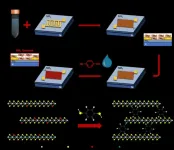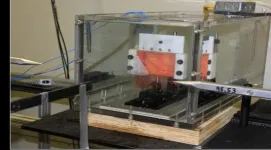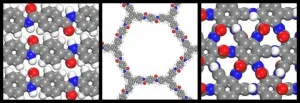(Press-News.org) Nanoengineers at the University of California San Diego have discovered new fundamental insights for developing lithium metal batteries that perform well at ultra-low temperatures; mainly, that the weaker the electrolyte holds on to lithium ions, the better. By using such a weakly binding electrolyte, the researchers developed a lithium metal battery that can be repeatedly recharged at temperatures as low as -60 degrees Celsius--a first in the field.
Researchers report their work in a paper published Feb. 25 in Nature Energy.
In tests, the proof-of-concept battery retained 84% and 76% of its capacity over 50 cycles at -40 and -60 degrees Celsius, respectively. Such performance is unprecedented, researchers said.
Other lithium batteries that have been developed for use in sub-freezing temperatures are capable of discharging in the cold but need warmth when charging. That means an extra heater must be brought on board to use these batteries in applications such as outer space and deep-sea exploration. The new battery, on the other hand, can be both charged and discharged at ultra-low temperature.
This work--a collaboration between the labs of UC San Diego nanoengineering professors Ping Liu, Zheng Chen and Tod Pascal--presents a new approach to improving the performance of lithium metal batteries at ultra-low temperature. Many efforts so far have focused on choosing electrolytes that don't freeze up so easily and can keep lithium ions moving quickly between the electrodes. In this study, UC San Diego researchers discovered that it's not necessarily how fast the electrolyte can move the ions, but how easily it lets go of them and deposits them on the anode.
"We found that the binding between the lithium ions and the electrolyte, and the structures that the ions take in the electrolyte, mean either life or death for these batteries at low temperature," said first author John Holoubek, a nanoengineering Ph.D. student at the UC San Diego Jacobs School of Engineering.
The researchers made these discoveries by comparing battery performance with two types of electrolytes: one that binds weakly to lithium ions, and one that binds strongly. Lithium metal battery cells with the weakly binding electrolyte performed better overall at -60 degrees Celsius; it was still running strong after 50 cycles. In contrast, cells with the strongly binding electrolyte stopped working after just two cycles.
After cycling the cells, the researchers took them apart to compare the lithium metal deposits on the anodes. The differences were also stark. Deposits were smooth and uniform in the cells with the weakly binding electrolyte, but chunky and needle-like in the cells with the strongly binding electrolyte.
Details matter
The differences in battery performance all come down to nanoscale interactions, the researchers said. "How lithium ions interact with the electrolyte at the atomic level not only enables sustainable cycling at very, very low temperature, but also prevents dendrite formation," Chen said.
To understand why, the team took a detailed look at these interactions using computational simulations and spectroscopic analysis. In one of the electrolytes, called diethyl ether (or DEE), the researchers observed molecular structures consisting of lithium ions weakly bound to the surrounding electrolyte molecules. In the other electrolyte, called DOL/DME, the researchers observed structures that feature strong binding between the ions and electrolyte molecules.
These structures and binding strengths are important, the researchers said, because they ultimately dictate how lithium deposits on the anode surface at low temperature. In weakly bound structures like those observed in the DEE electrolyte, Holoubek explained, lithium ions can easily leave the electrolyte's hold, so it doesn't take much energy to get them to deposit anywhere on the anode surface. This is why deposits are smooth and uniform in DEE. But in strongly bound structures, like those in DOL/DME, more energy is needed to pull lithium ions away from the electrolyte. As a result, lithium will prefer to deposit where the anode surface has an extremely strong electric field--anywhere there's a sharp tip. And lithium will continue to pile up on that tip until the cell short circuits. This is why deposits are chunky and dendritic in DOL/DME.
"Figuring out the different types of molecular and atomic structures that lithium forms, how lithium coordinates with certain atoms--these details matter," said Pascal, who directed the computational studies. "By understanding fundamentally how these systems come together, we can come up with all kinds of new design principles for the next generation of energy storage systems. This work demonstrates the power of nanoengineering, where figuring out what happens at the small scale enables the design of devices at the large scale."
Compatible cathode
These fundamental insights enabled the team to design a cathode that's compatible with the electrolytes and anode for low-temperature performance. It is a sulfur-based cathode made with materials that are low-cost, abundant and environmentally benign--no expensive transition metals are used.
"The significance of this work is really two-fold," said Liu, whose lab designed the cathode and has been optimizing the cycling performance of such a cathode in DEE for normal conditions. "Scientifically, it presents insights that are contrary to conventional wisdom. Technologically, it is the first rechargeable lithium metal battery that can deliver meaningful energy density while being fully operated at -60 C. Both aspects present a complete solution for ultra-low temperature batteries."
INFORMATION:
Paper title: "Tailoring Electrolyte Solvation for Li Metal Batteries Cycled at Ultra-Low Temperature."
This work was supported by a NASA Space Technology Graduate Research Opportunity, and in part by a NASA early career faculty award and by the U.S. Department of Energy.
The exfoliation of graphite into graphene layers inspired the investigation of thousands of layered materials: amongst them transition metal dichalcogenides (TMDs). These semiconductors can be used to make conductive inks to manufacture printed electronic and optoelectronic devices. However, defects in their structure may hinder their performance. Now, Graphene Flagship researchers have overcome these hurdles by introducing 'molecular bridges'- small molecules that interconnect the TMD flakes, thereby boosting the conductivity and overall performance.
The results, published in Nature Nanotechnology, come from a multidisciplinary collaboration between Graphene Flagship partners the University of Strasbourg and CNRS, France, AMBER and Trinity College Dublin, Ireland, ...
Human rights law can provide a transparent and fair framework for vaccine allocations, researchers suggest.
- All countries face the ethical challenge of how to allocate limited supplies of safe, effective COVID-19 vaccines
- Researchers say that governments should look to human rights principles and commitments to help them decide who should get priority for the first available doses of COVID-19 vaccine.
- A human rights approach would include social vulnerability alongside medical vulnerability in decision-making because health is affected by social factors.
- National vaccine roll-outs should take account of these overlapping vulnerabilities
As Governments around the world wrestle with the question of designing ...
Future fully autonomous vehicles will rely on sensors to operate, one type of these sensors is LiDAR
LiDAR sensor's effectiveness in detecting objects at a distance in heavy rain decreases, researchers from WMG, University of Warwick have found
Researchers used the WMG 3xD simulator to test the sensor detection of objects in rain, simulating real world roads and weather
High level autonomous vehicles (AVs) are promised by Original Equipment Manufacturers (OEMs) and technology companies to improve road safety as well as bringing economical and societal benefits to us all.
All high-level AVs rely heavily on sensors, and in the paper, 'Realistic LiDAR with Noise Model for Real-Tim Testing of Automated Vehicles in ...
PITTSBURGH--Babies whose births were depicted in Bollywood films from the 1950s and 60s were more often than not boys; in today's films, boy and girl newborns are about evenly split. In the 50s and 60s, dowries were socially acceptable; today, not so much. And Bollywood's conception of beauty has remained consistent through the years: beautiful women have fair skin.
Fans and critics of Bollywood -- the popular name for a $2.1 billion film industry centered in Mumbai, India -- might have some inkling of all this, particularly as movies often reflect changes in the culture. But these insights came via an automated computer analysis designed by Carnegie Mellon University computer ...
Sea turtles are witnesses and victims of the high level of plastic pollution of the Adriatic Sea. A group of researchers at the University of Bologna analysed 45 turtles hospitalised at Fondazione Cetacea in Riccione and found plastic debris in their faeces. Besides confirming the role of turtles as ideal sentinels to monitor plastic pollution in the sea, the results of their analysis - published in the journal Frontiers of Marine Medicine - crucially show how the plastic debris in their intestines can dangerously alter their microbiota, eventually compromising their health.
"The results ...
RESEARCH TRIANGLE PARK, N.C. -- Research shows that Soldiers exposed to shockwaves from military explosives are at a higher risk for developing Alzheimer's disease -- even those that don't have traumatic brain injuries from those blasts. A new Army-funded study identifies how those blasts affect the brain.
Researchers at the University of North Carolina at Pembroke in collaboration with the U.S. Army Combat Capabilities Development Command, now known as DEVCOM, the Army Research Laboratory, and the National Institutes of Health found that the mystery behind blast-induced neurological ...
UNIVERSITY PARK, Pa. -- The optimal timeframe for donating convalescent plasma for use in COVID-19 immunotherapy, which was given emergency use authorization by the Food and Drug Administration in August 2020, is within 60 days of the onset of symptoms, according to a new Penn State-led study. The research also reveals that the ideal convalescent plasma donor is a recovered COVID-19 patient who is older than 30 and whose illness had been severe.
"Millions of individuals worldwide have recovered from COVID-19 and may be eligible for participation in convalescent plasma donor programs," said Vivek Kapur, professor of microbiology and infectious diseases, Penn State. "Our findings enable identification ...
CHAMPAIGN, Ill. --Many climate models focus on scenarios decades into the future, making their outcomes seem unreliable and problematic for decision-making in the immediate future. In a proactive move, researchers are using short-term forecasts to stress the urgency of drought risk in the United States and inform policymakers' actions now.
A new study led by University of Illinois Urbana-Champaign civil and environmental engineering professor Ximing Cai examines how drought propagates through climate, hydrological, ecological and social systems throughout different U.S. regions. The results are published in the journal Geophysical Research Letters.
"The same amount of precipitation, or the lack of thereof, in one region could have very different impacts on the hydrologic ...
Black men and women, as well as adolescent boys and girls, may react differently to perceived racial discrimination, with Black women and girls engaging in more exercise and better eating habits than Black men and boys when faced with discrimination, according to research published by the American Psychological Association.
"In this study, Black women and girls didn't just survive in the face of racism, they actually responded in a positive manner, in terms of their health behavior," said lead researcher Frederick Gibbons, PhD, with the University of Connecticut. "This gives us some hope that despite the spike in racism across the country, some people are finding healthy ways to cope." ...
ADELPHI, Md. -- Army researchers reached a breakthrough in the nascent science of two-dimensional polymers thanks to a collaborative program that enlists the help of lead scientists and engineers across academia known as joint faculty appointments.
Researchers from the U.S. Army Combat Capabilities Development Command, now known as DEVCOM, Army Research Laboratory partnered with Prof. Steve Lustig, a joint faculty appointment at Northeastern University, to accelerate the development of 2D polymers for military applications.
The collaboration with ARL Northeast led to a groundbreaking study published in the peer-reviewed scientific journal Macromolecules. Editors featured the research in a cover article.
"2D polymers have been studied very seriously from a synthetic ...





